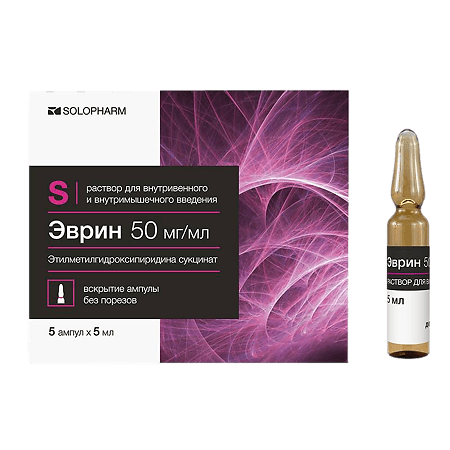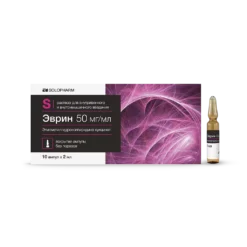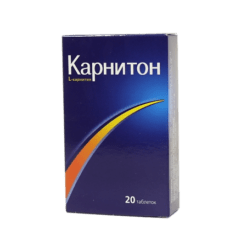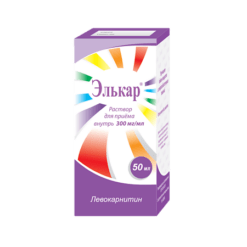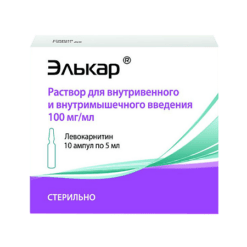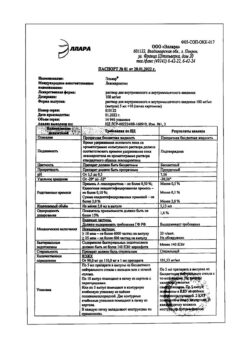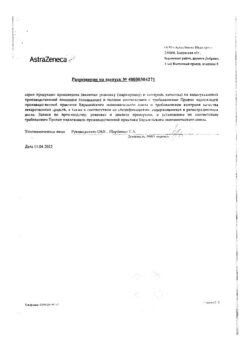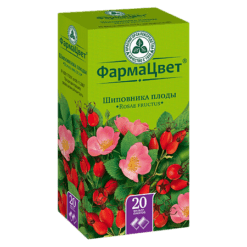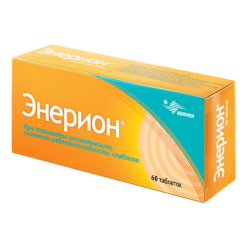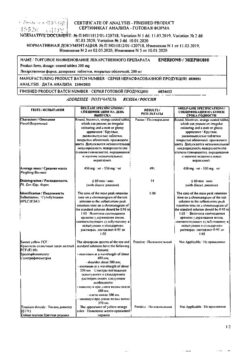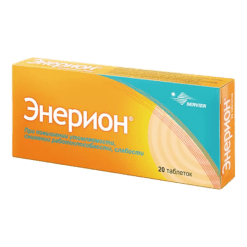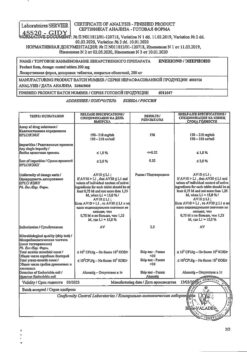No products in the cart.
Evrin, 50 mg/ml 5 ml 5 pcs
€1.00
Out of stock
(E-mail when Stock is available)
Description Pharmacotherapeutic group: Antioxidant Pharmacodynamics: Pharmacokinetics:
ATX: N.07.X.X Other drugs for the treatment of diseases of the nervous system
Ethylmethylhydroxypyridine succinate belongs to the class of 3-oxypyridines, is an inhibitor of free radical processes, membranoprotective. It also has an antihypoxic effect and increases the body’s resistance to stress.
The mechanism of action of ethylmethylhydroxypyridine succinate is due to its antioxidant and membrane-protective action. The drug inhibits lipid peroxidation, increases the activity of superoxidoxidase, increases the lipid-protein ratio and improves the structure and function of cell membranes.
Ethylmethylhydroxypyridine succinate models the activity of membrane-bound enzymes (calcium-independent phosphodiesterase, adenylate cyclase, acetylcholinesterase), receptor complexes (benzodiazepine, gamma-amino, acetylcholine), which increases their ability to bind to ligands, helps maintain the structural and functional organization of biomembranes, transport neurotransmitters and improve synaptic transmission. Ethylmethylhydroxypyridine succinate increases the content of dopamine in the brain. Causes enhancement of compensatory activation of aerobic glycolysis and reduction of the degree of inhibition of oxidative processes in the Krebs cycle under hypoxia with an increase in adenosine triphosphate (ATP) and creatine phosphate, activation of energy-synthesizing functions of mitochondria.
Increases the body’s resistance to various damaging factors in pathological conditions (hypoxia and ischemia, cerebral circulatory disorders, intoxication with ethanol and antipsychotic drugs).
In conditions of critical reduction of coronary blood flow promotes the preservation of structural and functional organization of cardiomyocyte membranes, stimulates the activity of membrane enzymes – phosphodiesterase, adenylate cyclase, acetylcholinesterase. Supports acetylcholinesterase activation that develops in acute ischemia. It supports activation of aerobic glycolysis developing in acute ischemia and promotes under hypoxia restoration of mitochondrial redox processes, increases ATP and creatine phosphate synthesis.
Provides integrity of morphological structures and physiological functions of ischemic myocardium. Improves clinical course of myocardial infarction, increases the effectiveness of current therapy, reduces the incidence of arrhythmias and intracardiac conduction abnormalities.
Normalizes metabolic processes in ischemic myocardium, increases antianginal activity of nitrates, improves rheological properties of blood, reduces consequences of reperfusion syndrome in acute coronary failure.
It promotes the preservation of retinal ganglion cells and optic nerve fibers in progressive neuropathy caused by chronic ischemia and hypoxia. It improves the functional activity of the retina and the optic nerve, increasing visual acuity.
Limits enzymatic toxemia and endogenous intoxication in acute pancreatitis.
It improves metabolism and blood supply of the brain, microcirculation and rheological properties of the blood, reduces platelet aggregation. It stabilizes blood cell membranes (erythrocytes and platelets), reducing the possibility of hemolysis. It has a hypolipidemic effect by reducing the content of total cholesterol and low-density lipoproteins.
Intake
In single and course administration, the maximum concentration (Cmax) in blood plasma is reached after 0.58 h. When administered in a dose of 400-500 mg, the Cmax in plasma is 3.5-4 mcg/ml.
Distribution
It is rapidly distributed in organs and tissues. Average retention time of ethylmethylhydroxypyridine succinate in the body is 0.7-1.3 h.
Metabolism
Metabolized in the liver by glucuronidation. Five metabolites were identified: 3-oxypyridine phosphate – formed in the liver and with the help of alkaline phosphatase breaks down into phosphoric acid and 3-oxypyridine; the 2nd metabolite – pharmacologically active, formed in large amounts and found in the urine 1-2 days after administration; the 3rd – excreted in large amounts in the urine; the 4th and 5th – glucuronconjugates.
Elimation
Extracted from the blood plasma rapidly and practically undetectable after 4 hours in the blood plasma. It is rapidly excreted in the urine, mainly as metabolites (50% in 12 hours), and in a small amount – unchanged (0.3% in 12 hours). Rates of urinary excretion of unchanged ethylmethylhydroxypyridine succinate and metabolites have individual variability.
.
Indications
Indications
– Acute cerebrovascular accidents (as part of complex therapy);
– traumatic brain injury, consequences of traumatic brain injury;
– dyscirculatory encephalopathy;
– syndrome of vegetative (neurocirculatory) dystonia;
– mild cognitive disorders of atherosclerotic origin;
– anxiety disorders in neurotic and neurosis-like conditions;
– acute myocardial infarction (from the first day) as part of complex therapy;
– primary open-angle glaucoma of various stages, as part of complex therapy;
– relief of withdrawal syndrome in alcoholism with a predominance of neurosis-like and vegetative-vascular disorders;
– acute intoxication with antipsychotic drugs;
– acute purulent-inflammatory processes of the abdominal cavity (acute necrotizing pancreatitis, peritonitis) as part of complex therapy.
Pharmacological effect
Pharmacological effect
Pharmacotherapeutic group: Antioxidant
ATC: N.07.X.X Other drugs for the treatment of diseases of the nervous system
Pharmacodynamics:
Ethylmethylhydroxypyridine succinate belongs to the class of 3-hydroxypyridines, is an inhibitor of free radical processes, and a membrane protector. It also has an antihypoxic effect and increases the body’s resistance to stress.
The mechanism of action of ethylmethylhydroxypyridine succinate is due to its antioxidant and membrane protective effect. The drug inhibits lipid peroxidation, increases the activity of superoxide oxidase, increases the lipid-protein ratio, and improves the structure and function of the cell membrane.
Ethylmethylhydroxypyridine succinate models the activity of membrane-bound enzymes (calcium-independent phosphodiesterase, adenylate cyclase, acetylcholinesterase), receptor complexes (benzodiazepine, gamma-aminobutyric, acetylcholine), which enhances their ability to bind to ligands, contributes to the preservation of the structural and functional organization of biomembranes, neurotransmitter transport and improvement synaptic transmission. Ethylmethylhydroxypyridine succinate increases dopamine levels in the brain. Causes an increase in compensatory activation of aerobic glycolysis and a decrease in the degree of inhibition of oxidative processes in the Krebs cycle under hypoxic conditions with an increase in the content of adenosine triphosphate (ATP) and creatine phosphate, activation of the energy-synthesizing functions of mitochondria.
Increases the body’s resistance to the effects of various damaging factors in pathological conditions (hypoxia and ischemia, cerebrovascular accidents, intoxication with ethanol and antipsychotic drugs).
In conditions of a critical decrease in coronary blood flow, it helps to preserve the structural and functional organization of cardiomyocyte membranes, stimulates the activity of membrane enzymes – phosphodiesterase, adenylate cyclase, acetylcholinesterase. Supports the activation of acetylcholinesterase that develops during acute ischemia. Supports the activation of aerobic glycolysis that develops during acute ischemia and promotes the restoration of mitochondrial redox processes under hypoxic conditions, increases the synthesis of ATP and creatine phosphate.
Ensures the integrity of the morphological structures and physiological functions of the ischemic myocardium. Improves the clinical course of myocardial infarction, increases the effectiveness of therapy, reduces the incidence of arrhythmias and intracardiac conduction disorders.
Normalizes metabolic processes in ischemic myocardium, increases the antianginal activity of nitrates, improves the rheological properties of blood, reduces the consequences of reperfusion syndrome in acute coronary insufficiency.
Promotes the preservation of retinal ganglion cells and optic nerve fibers during progressive neuropathy, the causes of which are chronic ischemia and hypoxia. Improves the functional activity of the retina and optic nerve, increasing visual acuity.
Reduces enzymatic toxemia and endogenous intoxication in acute pancreatitis.
Improves metabolism and blood supply to the brain, microcirculation and rheological properties of blood, reduces platelet aggregation. Stabilizes the membranes of blood cells (erythrocytes and platelets), reducing the likelihood of hemolysis. It has a lipid-lowering effect by reducing the content of total cholesterol and low-density lipoproteins.
Pharmacokinetics:
Suction
With a single and course dose, the maximum concentration (Cmax) in the blood plasma is achieved after 0.58 hours. When administered at a dose of 400-500 mg, Cmax in the blood plasma is 3.5-4 μg/ml.
Distribution
Quickly distributed in organs and tissues. The average retention time of ethylmethylhydroxypyridine succinate in the body is 0.7-1.3 hours.
Metabolism
Metabolized in the liver by glucuronidation. 5 metabolites have been identified: 3-hydroxypyridine phosphate – formed in the liver and, with the participation of alkaline phosphatase, breaks down into phosphoric acid and 3-hydroxypyridine; 2nd metabolite – pharmacologically active, formed in large quantities and found in urine 1-2 days after administration; 3rd – excreted in large quantities in the urine; 4th and 5th – glucuron conjugates.
Removal
It is eliminated from blood plasma quickly and is practically undetectable after 4 hours in it. It is rapidly excreted in the urine, mainly in the form of metabolites (50% in 12 hours), and in small quantities unchanged (0.3% in 12 hours). The urinary excretion rates of unchanged ethylmethylhydroxypyridine succinate and metabolites have individual variability.
Special instructions
Special instructions
The drug is not prescribed to children under 18 years of age due to insufficient knowledge of the drug’s effect.
Impact on the ability to drive vehicles. Wed and fur.:
During the treatment period, care must be taken when driving vehicles and engaging in other potentially hazardous activities that require increased concentration and speed of psychomotor reactions.
Active ingredient
Active ingredient
Ethylmethylhydroxypyridine succinate
Composition
Composition
1 ml of the drug contains:
Active ingredient:
Ethylmethylhydroxypyridine succinate – 50.0 mg
Excipients:
Sodium disulfite – 0.47 mg,
Water for injection up to 1.0 ml
Pregnancy
Pregnancy
Experimental studies did not reveal teratogenic, mutagenic or embryotoxic effects. Adequate and strictly controlled clinical studies have not been conducted during pregnancy and lactation. The drug is contraindicated during pregnancy and breastfeeding due to insufficient data on the effectiveness and safety of the drug during these periods.
Contraindications
Contraindications
– Hypersensitivity to the drug;
– acute liver and/or kidney failure;
– children’s age;
– pregnancy;
– breastfeeding period – due to the lack of data on effectiveness and safety.
With caution:
History of allergic diseases.
Side Effects
Side Effects
From the digestive system: nausea, dry oral mucosa or metallic taste in the mouth, flatulence, diarrhea.
From the nervous system: drowsiness, difficulty falling asleep.
From the respiratory system: sore throat, chest discomfort, feeling of lack of air (usually associated with an excessively high rate of administration and is short-term in nature).
From the cardiovascular system: short-term increase in blood pressure.
Other: allergic reactions, feeling of “spreading warmth” throughout the body, unpleasant odor.
Interaction
Interaction
Enhances the effect of benzodiazepine anxiolytics, antiepileptic (carbamazepine), antiparkinsonian (levodopa) drugs.
Reduces the toxic effect of ethanol.
Overdose
Overdose
Due to low toxicity, overdose is unlikely. In case of accidental overdose, sleep disturbance (insomnia), in some cases drowsiness and sedation, may occur. When administered intravenously, an increase in blood pressure is possible.
Treatment
As a rule, it is not required – the symptoms disappear on their own within 24 hours. In especially severe cases of insomnia, it is recommended to use one of the sleeping pills and anxiolytics for oral administration (nitrazepam 10 mg, oxazepam 10 mg or diazepam 5 mg). If blood pressure is excessively high, use antihypertensive drugs under blood pressure control.
Storage conditions
Storage conditions
In consumer packaging, at a temperature not exceeding 25 °C.
Keep out of the reach of children.
Shelf life
Shelf life
3 years.
Do not use after the expiration date.
Manufacturer
Manufacturer
Grotex LLC, Russia
Additional information
| Shelf life | 3 years. Do not use after the expiration date. |
|---|---|
| Conditions of storage | In the consumer package, at a temperature not exceeding 25 ° C. Store out of reach of children. |
| Manufacturer | Grotex Ltd, Russia |
| Medication form | solution |
| Brand | Grotex Ltd |
Other forms…
Related products
Buy Evrin, 50 mg/ml 5 ml 5 pcs with delivery to USA, UK, Europe and over 120 other countries.

